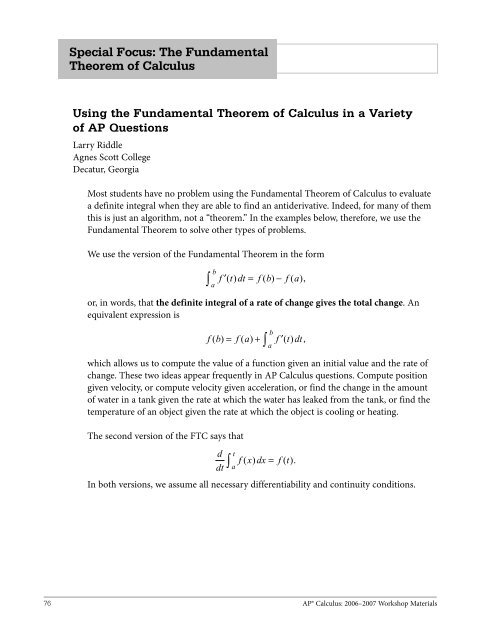AP Calculus
Calculus_SF_Theorem
Calculus_SF_Theorem
You also want an ePaper? Increase the reach of your titles
YUMPU automatically turns print PDFs into web optimized ePapers that Google loves.
Special Focus: The Fundamental<br />
Theorem of <strong>Calculus</strong><br />
Using the Fundamental Theorem of <strong>Calculus</strong> in a Variety<br />
of <strong>AP</strong> Questions<br />
Larry Riddle<br />
Agnes Scott College<br />
Decatur, Georgia<br />
Most students have no problem using the Fundamental Theorem of <strong>Calculus</strong> to evaluate<br />
a definite integral when they are able to find an antiderivative. Indeed, for many of them<br />
this is just an algorithm, not a “theorem.” In the examples below, therefore, we use the<br />
Fundamental Theorem to solve other types of problems.<br />
We use the version of the Fundamental Theorem in the form<br />
b<br />
a<br />
∫ f ′( t) dt = f ( b) − f ( a),<br />
or, in words, that the definite integral of a rate of change gives the total change. An<br />
equivalent expression is<br />
b<br />
a<br />
f ( b) = f ( a) + ∫ f ′( t)<br />
dt ,<br />
which allows us to compute the value of a function given an initial value and the rate of<br />
change. These two ideas appear frequently in <strong>AP</strong> <strong>Calculus</strong> questions. Compute position<br />
given velocity, or compute velocity given acceleration, or find the change in the amount<br />
of water in a tank given the rate at which the water has leaked from the tank, or find the<br />
temperature of an object given the rate at which the object is cooling or heating.<br />
The second version of the FTC says that<br />
d t<br />
f x dx f t<br />
dt<br />
∫ ( ) = ( ).<br />
a<br />
In both versions, we assume all necessary differentiability and continuity conditions.<br />
76<br />
<strong>AP</strong>® <strong>Calculus</strong>: 2006–2007 Workshop Materials


